Apple continues to redefine the user experience with its recent announcements, paving the way for a revolutionary design language known as Liquid Glass, showcased at the WWDC 2025. This innovation promises to bring a fresh aesthetic while retaining functionality across all devices, including the highly anticipated iPhone 16 Pro. While such bold upgrades can disrupt our comfort zone, they also kindle excitement about the possibilities that lie ahead.
The Aesthetics of Liquid Glass
At first glance, the changes introduced by Liquid Glass can feel overwhelming. The app icons, with their shimmering, translucent surfaces, indeed offer an eye-catching visual experience that attempts to mimic the interplay between light and texture. The design employs a degree of translucency that allows glimpses of the user’s wallpaper beneath the app layers—an artistic endeavor that underscores Apple’s commitment to a fluid and visually captivating interface.
However, as alluring as this glassy finish may seem, the initial experience can come off as jarring. One of the core issues reported is the confusion that arises from the lack of visual clarity. The transparency, while sophisticated, can contribute to overcrowding on a user’s home screen, reducing legibility and ease of navigation. The challenge will be for Apple to harmonize beauty with practical usability, ensuring that the visual appeal does not cloud the user experience.
Functional Changes and User Experience
Delving deeper into the interface reveals a host of functional enhancements accompanied by quirks that merit attention. For example, the Control Center, which generally serves as a crucial hub for quick settings adjustments, suffers from an overwhelming sense of clutter due to its new Liquid Glass design. Many users, including seasoned iPhone owners, may find it challenging to navigate the Control Center efficiently, particularly with the current transparency levels that obscure less frequently used functions.
Although some elements of the Liquid Glass design promise innovation, like the watery animations introduced within the Clock app, many users are left wishing for conventional design elements that prioritize ease of use. For instance, altering the shape of buttons from circular to oval may be visually pleasing, but it can invite confusion among those accustomed to iOS’s former interface. It brings forth the question of whether aesthetics should ever supersede functionality in user interface design.
The Keyboard and Safari: A Mixed Bag
Another critical component that reflects the duality of innovation is the newly revamped keyboard and the layout of Safari. The keyboard redesign, while intended to freshen the visual landscape, extends too much space between options, disrupting the fluidity users have come to expect. Margins that are excessively wide may lead to frustration as users grapple with a less compact design that throws off their typing rhythm.
Similarly, the URL bar’s responsiveness, influenced by Liquid Glass, introduces bendy animations that, while intriguing, raise apprehensions about practicality. These transition effects, while novel, could distract users during tasks that demand swift and straightforward navigation.
The Evolution of Acceptance
Despite the initial reservations, an intriguing phenomenon occurs when users engage with the Liquid Glass design over time. Unlike many, the writer found that the changes become endearing after several hours with the iOS 26 developer beta version. This acceptance reflects a broader theme within technology: initial resistance often gives way to appreciation as users adjust to new paradigms.
The reality is that such radical changes serve as a compelling reminder of the transformative journeys users undertake with technology. While fine-tuning and modifications will be necessary before the official launch, the inherent promise of Liquid Glass shines through, hinting at an exhilarating future.
In sum, Apple’s Liquid Glass approach is a bold attempt at merging artistry with technology, despite presenting an array of challenges that can disrupt the experience. The interplay between the visually stunning and the functionally sound remains a dynamic tension that will require careful navigation as technology evolves in the coming years.


Leave a Reply